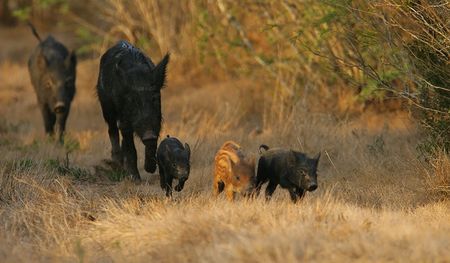Feral hogs typically look very similiar to domestic hogs, but often times have more variation in color and coat pattern. Although color can vary between white, red, and brown for recently hogs that have recently gone feral, the most common color in established feral hog populations is black. This is probably because predators, even hunters, select for easily spotted animals. In addition, because feral hogs are often times active at night, black blends well.
A mature feral hog may reach a shoulder height of 32 to 38 inches and weigh from 100 pounds up 400 pounds. Male hogs, or boars, are generally larger than the females, or sows. Hogs that are very large in size are generally not far removed from domestication, meaning that individual, its parents, or grandparents were likely domestic hogs.

Males (boars) are generally larger than females. Often times, much larger. European (Russian wild boar) wild hogs are about the same size as run-of-the-mill feral hogs, but European wild hogs usually have longer legs and snouts. European wild hogs can be identified because they usually have a larger head in proportion to their body, their body is covered with long stiff hairs, they have long side whiskers, and their tail is longer and straighter tail. In addition, European wild hogs have a nape on their neck, which gives them the “razorback” appearance. The crossing of European wild hogs and feral hogs often produces offspring with some European characteristics.
Feral hogs are more muscular than domestic pen-raised hogs and have very little fat. Feral and wild hogs are born a tan or reddish color and have black longitudinal stripes. As the piglets (baby pigs) mature into shoats (young pigs) the coat color becomes predominately darker, often dark brown or black.
Feral hogs have four continuously growing tusks, two on top and two on bottom. The contact of the upper and lower tusks causes a continuous sharpening of the lower tusks. Though these tusks make the feral hog tough opposition for hog hunters and predators, they have relatively poor eyesight, which makes them easy to sneak up on if you remain down wind and quiet. Feral hogs have excellent hearing and sense of smell.
This page will discuss general biology and link to history, distribution, characteristics